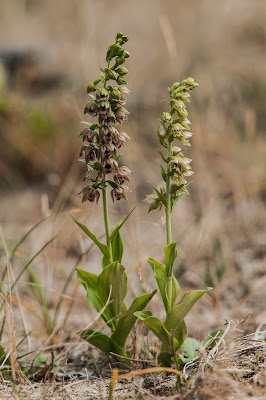Epipactis helleborine, also called as Broad Leafed Helleborine is found growing in moist to dry, rocky, shaded, deciduous to mixed woods; cedar swamps
Epipactis helleborine, also called as Broad Leafed Helleborine, Helleborine helleborine, Serapias helleborine, is a species of the genus Epipactis. This species was described by Heinrich Johann Nepomuk von Crantz in 1769.
IDENTIFY EPIPACTIS HELLEBORINE - BROAD LEAFED HELLEBORINE
Epipactis helleborine is native to Northwestern Africa, Europe to China. It is found growing in moist to dry, rocky, shaded, deciduous to mixed woods; cedar swamps and forested stream margins; often in disturbed places such as lawns, and cracks in concrete sidewalks at elevations of 0-2500 meters above sea level.
It is a large sized, cool to cold growing terrestrial which reaching 25-80 cm in height with short rhizome. The stem is glabrous toward base, becoming pubescent above, with 2 or 3 scalelike sheaths near base. The leaves are 3–10, orbiculate, elliptic to narrowly lanceolate, 4–18 × 1.5–8.5 cm, glabrous, apex acuminate to long acuminate.
Broad Leafed Helleborine blooms in the late spring and summer from the 10-30 cm, pubescent, laxly to subdensely 3-50-flowered inflorescence. The flowers are small; sepals greenish, often suffused with purple; petals pale green, pink, purple, or yellowish; lip indistinctly veined, constricted at middle into 2 parts, proximal part purplish to brownish, distal part pink; calli brownish. There are however some described color variations to these plants: White flowered, yellow flowered, albino form with white flowers, variegated form, and green flowered.
EPIPACTIS HELLEBORINE - BROAD LEAFED HELLEBORINE CARE AND CULTURE
Cultural information should only be used as a guide, and should be to be adapted to suit you. Your physical location; where you grow your plants, how much time you have to devote to their care, and many other factors, will need to be taken into account. Only then can you decide on the cultural methods that best suit you and your plants.
Light:
Epipactis helleborine are best positioned in an area that attracts partial sunlight as they will thrive better in shady spaces. These plants can be planted in full sunlight on condition that the substrate is prevented from becoming dry in summer.
Humidity:
Broad Leafed Helleborine needs the humidity level of 40-70%. Too dry air has a negative effect on the development of the plant: its growth is inhibited, and the leaves begin to turn yellow and dry out. The higher temperature, the higher the humidity should be, and the higher the humidity, the more often and longer it is necessary to ventilate the room where the plants are contained, otherwise the probability of rotting and various kinds of fungal diseases.
If the humidity levels are consistently too low, consider buying a humidifier to increase the humidity level. Another way of increasing humidity is by setting your plants on trays filled with pebbles or gravel and with water, but plants should not be in contact with the water.
Temperature:
The plants grow best at summer days average of 22-25 °C, and nights average 17-19 °C, with a diurnal range of 5- 8°C. Winter days average 14-16 °C, and nights average 9-11 °C, with a diurnal range of 5-7 °C.
Substrate and growing media:
Epipactis helleborine tolerate many conditions as long as pH is neutral, between 5.5 and 7 . They are best planted in moist well-drained soil of clay, chalk or loam within an acidic, alkaline or neutral PH balance. At the time of planting you may wish to supplement native soil with a generous amount of compost to maintain good moisture levels in the summer and to promote better drainage during the winter. You can use many media such as pumice gravel, coarse sand , loam and clay (max 5 %) , peat, fen soil , sphagnum , coco peat, oyster shells . Organics preferable less than 20 %.
Repotting is done once in two to three years in autumn, winter and spring when still dormant, or in late spring when growths have reached maturity.
Watering:
Broad Leafed Helleborine require consistently moist soil to thrive and so therefore it is vital to water plants regularly throughout active growth and during prolonged periods of dry weather. Do not let your plants dry out at any time of the year, even during autumn and winter. Soil may not be too wet in full summer, risk of anaerobic soils. Warm compost with standing water is very dangerous! Rainwater is advisable, otherwise good quality tap water chlorine poor. Good oxygen rich water is essential.
Watering is directly dependent on the temperature of the content, the higher it is, the more often it needs to be watered. When watering, excess water should flow freely from the pot, since stagnation of water both inside the pot and in its pan can very quickly lead to rotting of the roots and the lower part of the plant.
Fertilizer:
This plant is an easy strong growing orchid, that needs more fertiliser as other species, so one may use a good quality chemical fertiliser in growing phase, dissolved in the water as a surplus. As basic fertiliser you can use slow release grains once a year, 10 grains per mature plant in spring when shoots break through the surface.
Rest period:
During the winter, Epipactis helleborine persists in rhizome form and develops new shoots in the spring. They are the very cold-resistant and do not require any special protection in winter. It is possible to propagate by seed or by division once the plants are well-established. Highly proliferative, these orchids will quickly form colonies of several hundred head following the successive growth and dormancy cycles.















COMMENTS